Synopsis: Allied soldiers from Belgium, the British Empire, Canada, and France are surrounded by the German army and evacuated during a fierce battle in World War II.
Release Date: July 21, 2017 MPAA Rating: PG-13
Genre(s): Action, Drama
Film Review
 Production
Production
In his career, director Christopher Nolan has dealt with superheroes (The Dark Knight trilogy), outer space (Interstellar), dreams (Inception), and even the selective human memory (Memento). Now, for something completely different, he takes on the historical war re-enactment subgenre with his new movie Dunkirk.
Just as the name implies, Dunkirk deals with the World War II allied evacuation of Dunkirk, France. Hundreds of thousands of British and French soldiers had been driven to a beach at the northernmost tip of the country and were effectively pinned down by German troops. With the British navy unable to get close enough to the beach to aid with the extraction, a small fleet of private volunteer boats was requisitioned to help. Dunkirk is the thrilling account of how the survivors got out.
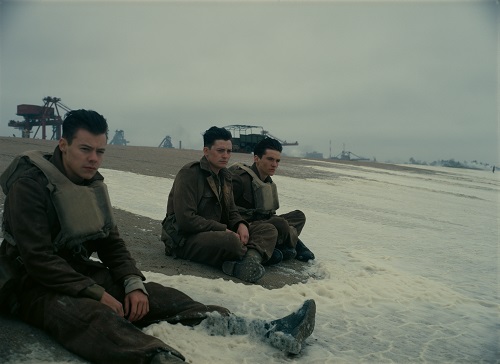
Dunkirk shows its events from three different angles that occur over three different timelines. First, there are the struggles of the soldiers on the beach, shown through the eyes of a trio of shell-shocked boys (newcomer Fionn Whitehead, Citadel‘s Aneurin Barnard, and British pop star Harry Stiles from the group One Direction) as well as the field commanders of both the British Navy and Army (Valkyrie‘s Kenneth Branagh and Cloud Atlas‘ James D’Arcy). This section of the film is referred to as The Mole (a pier, not a spy), and covers roughly one week.
Then, there’s action aboard a small vessel called the Moonstone, captained by a citizen (Mark Rylance from Bridge of Spies) and crewed by his son and his son’s friend (Tom Glynn-Carney from “The Last Post” and Barry Keoghan from ’71), that crosses the English channel to aid in the rescue effort. One of the first men they save is a shivering soldier (Free Fire‘s Cillian Murphy) who they find sitting on the wreckage of his warship, and who wants nothing to do with heading back in the direction of France. This is The Sea and takes place over the course of one day.
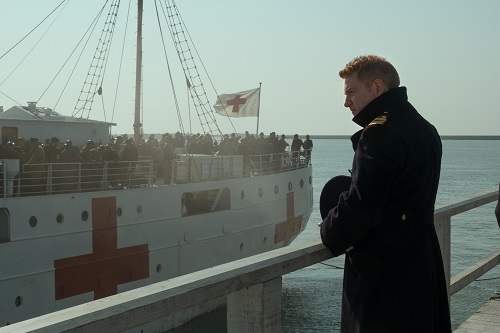
Finally, there is The Air, which revolves around a pair of pilots (Tom Hardy from Mad Max: Fury Road and Jack Lowden from England is Mine) who fly their Royal Air Force Spitfires to Dunkirk to supply badly needed air support for the evacuation, taking out bomber planes that are intent on sinking the boats and ships that are filled with wounded and tired soldiers. This mission lasts an hour.
The genius of Dunkirk comes in how Christopher Nolan manages to weave the three stories together despite the fact that they take place over different periods of time. While they are not exactly happening concurrently, the sections do interconnect, and they finally do end up in the same place. But audiences have grown to expect that kind of time and space warping from Nolan. They’ve just never seen it applied to such a realistic environment.
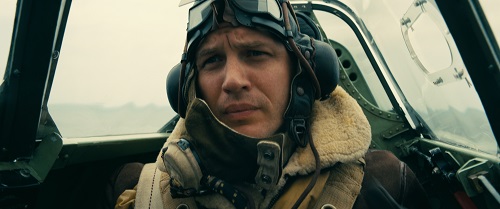
And Nolan does pack quite a bit of realism into Dunkirk. Between working with a historical consultant on the film and hiring actors who are familiar with the actual event (Tom Hardy’s father was even at Dunkirk and would regale him with stories of the escape), Nolan provides a sense of authenticity and truth to his telling of the story. Each overlapping segment has its own historical stylistic influences, so it’s a bit like three movies in one that just happen to coexist and coincide.
The Mole is visceral and disturbing, like the opening scene of Saving Private Ryan. The Air is thrilling and exciting, reminding the viewer of something like Red Tails. The Sea is more thoughtful and philosophical, a calm before the storm while the seamen make their way to the action, sort of like the boat scenes during the last half of Jaws.
Even with all of these different tones and vibes, Nolan manages to keep Dunkirk coherent; despite its wandering tangents and momentary detours, it’s still a singular vision. The large ensemble cast is exactly that – an ensemble. Each performance is individual and stands upon its own merits, but there is no lead character in the movie. It’s every man for himself. Unless you’re a big fan of One Direction, the most bankable star in the film is Nolan’s pal Tom Hardy, and his face is obscured by an oxygen mask for most of the movie, rendering him virtually unrecognizable (similar to what Nolan did to him when he played Bane in The Dark Knight Rises). Dunkirk doesn’t rely on star power. It’s a sum-of-its-parts kind of movie.
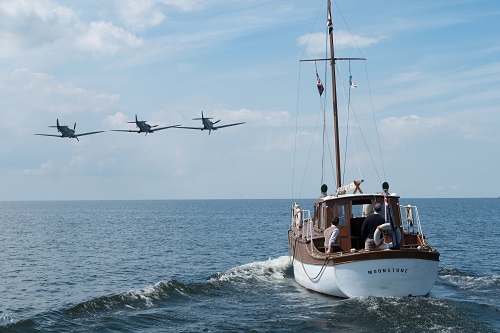
Dunkirk is actually more of an immersive experience than it is a movie. This was undoubtedly Christopher Nolan’s intention, and for the most part, it works, with the audience being placed right into battle alongside the characters. As a war movie, it’s somewhere near the middle of the pack; the large cast and shifting points of view keep the audience from relating too heavily to any one character, but there’s enough action to keep things moving at a brisk and firm pace.
Dunkirk does pretty much what Nolan set out for it to do, which is to tell a compelling story in an interesting way. And, unlike his last few movies, it doesn’t linger any longer than it has to. From a film auteur’s standpoint, Dunkirk is another feather in Christopher Nolan’s cap.
 Sound
Sound
The sound mix in Dunkirk is excruciating. Of course, that’s probably by design, as Christopher Nolan is trying to toss his audience right into the thick of things, but one second the viewer is leaning forward to try and hear a quietly whispered conversation, and the next they’re holding their ears, wincing in pain from a round of gunfire or the explosion of a bomb. The sound effects are loud, tense, and unsettling, but they’re also brash, abrasive, and obnoxious.
Yes, Nolan is trying to communicate the shock and awe of war, but from an audio perspective, there are ways to rumble the seats without causing the audience’s eardrums to bleed. Even the score, which is an atypical phone-in effort by Nolan’s go-to guy Hans Zimmer (Hidden Figures, Chappie), is more sound design than music, full of dissonant swells and atonal washes, only making up in volume what it lacks in creativity. If you’re going to venture out to an IMAX theater for Dunkirk, be prepared. Bring earplugs.
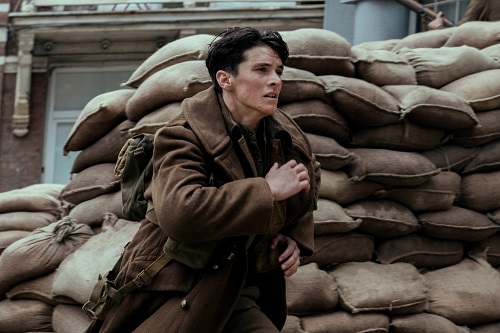
Cast and Crew
- Director(s): Christopher Nolan
- Producer(s): Christopher Nolan, Emma Thomas
- Screenwriter(s): Christopher Nolan
- Cast: Fionn Whitehead (Tommy), Aneurin Barnard (Gibson), Harry Styles (Alex), Mark Rylance (Mr. Dawson), Tom Glynn-Carney (Peter). Barry Keoghan (George), Cillian Murphy (Shivering Soldier), Tom Hardy (Farrier), Jack Lowden (Collins), James D’Arcy (Colonel Winnant), Kenneth Branagh (Commander Bolton)
- Editor(s): Lee Smith
- Cinematographer: Hoyte Van Hoytema
- Costume Designer: Jeffrey Kurland
- Casting Director(s): John Papsidera, Toby Whale
- Music Score: Hans Zimmer
- Country Of Origin: USA, UK

